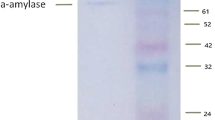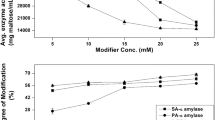Abstract
α-Amylases reported from various microbial sources have been shown to be moderately thermostable and Ca2+ dependent. The bacterial strain used in this investigation is an extremely thermophilic bacterium Geobacillus thermoleovorans that produces a novel α-amylase (26 kDa; α-amylase gt), which is hyperthermostable (T opt 100 °C) and does not require Ca2+ for its activity/stability. These special features of α-amylase gt make it applicable in starch saccharification process. The structural aspects of α-amylase gt are, therefore, of significant interest to understand its structure–function relationship. The circular dichroism spectroscopic data revealed the native α-amylase gt to contain 25% α-helix, 21% β-sheet, and 54% random coils. The addition of urea, at high concentration (8 M), appeared to expose the buried Trp residues of the native α-amylase gt to the aqueous environment and thus showed low fluorophore. Fluorescence-quenching experiments using KI, CsCl, N-bromosuccinimide, and acrylamide revealed interesting features of the tryptophan microenvironment. Analysis of K sv and f a values of KI, CsCl, and acrylamide suggested the overall Trp microenvironment in α-amylase to be slightly electropositive. Fluorescence-quenching studies with acrylamide revealed the occurrence of both collisional as well as static quenching processes. There was no change in the α-helix content or the enzyme activity with an increase in temperature (60–100 °C) that suggested a critical role of the α-helix content in maintaining the catalytic activity.








Similar content being viewed by others
References
Leuschner, C., & Antranikian, G. (1995). World Journal of Microbiology & Biotechnology, 11, 95–114.
Sunna, A., Moracci, M., Rossi, M., & Antranikian, G. (1997). Extremophiles, 1, 12–13.
Schwerdtfeger, R. M., Chiaraluce, R., Consalvi, V., Scandurra, R., & Antranikian, G. (1999). European Journal of Biochemistry, 264, 479–487.
Sajedi, R. H., Manesh, H. N., Khajeh, K., Ranjbar, B., Ghaemi, N., & Manesh, M. N. (2004). Applied Biochemistry and Biotechnology, 119, 41–50.
Antranikian, G. (1992). Microbial degradation of starch. In G. Winkelmann (Ed.) Microbial degradation of natural products (pp. 27–51). Weinheim, Germany: VCH.
Pandey, A., Nigam, P., Soccol, C. R., Soccol, V. T., Singh, D., & Mohan, R. (2000). Biotechnology and Applied Biochemistry, 1, 135–152.
Dey, G., Mitra, A., Banerjee, R., & Maiti, B. R. (2001). Biochemical Engineering Journal, 7, 227–231.
Van der Maarel, M. J. E. C., Van der Veen, B., Uitdehaag, J. C. M., Leemhuis, H., & Dijhuizen, L. (2002). Journal of Biotechnology, 94, 137–155.
Uma Maheswar Rao, J. L., & Satyanarayana, T. (2003a). Letters in Applied Microbiology, 36, 191–196.
Uma Maheswar Rao, J. L., & Satyanarayana, T. (2007). Applied Biochemistry and Biotechnology, 142, 179–193.
Uma Maheswar Rao, J. L., & Satyanarayana, T. (2004a). Journal of Applied Microbiology, 97, 1015–1020.
Uma Maheswar Rao, J. L., & Satyanarayana, T. (2004b). Indian Journal of Microbiology, 44, 281–284.
Satyanarayana, T., Noorwez, S. M., Kumar, S., Rao, J. L. U. M., Ezhilvannan, M., & Kaur, P. (2004). Biochemical Society Transactions, 32, 276–278.
Declerck, N., Machius, M., Chamber, R., Wiegand, G., Huber, R., & Gaillardin, C. (1997). Protein Engineering, 10, 541–549.
Rao, M. V. R., Atreyi, M., & Rajeswari, M. R. (1984). Journal of Biosciences, 6, 823–828.
Matsuura, Y., Kusunoki, M., Harada, W., & Kakudo, M. (1984). American Journal of Biochemistry, 95, 697–702.
Bandivadekar, K. R., & Deshpande, V. V. (1996). Biochemical Journal, 315, 583–587.
Spande, T. F., & Witkop, B. (1967). Methods in Enzymology, 11, 498–506.
Bernfeld, P. (1955). Amylases, a and b. In S. P. Colowick, & O. N. Kaplan (Eds.) Methods in enzymology (pp. 140–146). New York: Academic.
Bradford, M. A. (1976). Analytical Biochemistry, 72, 248–254.
Asouli, Y. B., Lidji, K., & Osman, F. (2004). American Biotechnology Laboratory, 2, 14–15.
Uma Maheswar Rao, J. L., & Satyanarayana, T. (2007). Bioresource Technology, 98, 345–352.
Koch, R., Zablowski, P., Spreinat, A., & Antranikian, G. (1990). FEMS Microbiology Letters, 71, 21–26.
Koch, R. A., Lemka, K., & Antranikian, G. (1991). Letters in Applied Microbiology, 31, 378–384.
Brzozowski, A. M., Lawson, D. M., Turkenburg, J. P., Bisgaard-Frantzen, H., Svendsen, A., Borchert, T. V., et al. (2000). Biochemist, 39, 9099–9107.
Gao, S., An, J., Wu, C. F., Gu, Y., Chen, F., Yu, Y., et al. (2005). Acta Biochimica et Biophysica Sinica, 37, 47–54.
Eftink, M. R., & Ghiron, C. A. (1981). Analytical Biochemistry, 114, 199–227.
Ghatge, M. S., & Deshpande, V. V. (1993). Biochemical and Biophysical Research Communications, 193, 979–984.
Igarashi, K., Hatada, Y., Hagihara, H., Saeki, K., Takaiwa, M., Uemura, T., et al. (1998). Applied and Environmental Microbiology, 64, 3282–3289.
Hamilton, L. M., Kelly, C. T., & Fogarty, W. M. (1999). Biotechnology Letters, 21, 111–115.
Kuriki, T., Yanase, M., Takata, H., Takesada, Y., Imanaka, T., & Okada, S. (1993). Applied and Environmental Microbiology, 59, 953–959.
Pattnaik, B. R., Ghosh, S., & Rajeswari, R. (1997). Biochemistry and Molecular Biology International, 42, 173–181.
Acknowledgments
We wish to thank Dr. M.R. Rajeswari, Ms. S. Akanchha, and Mr. J. Vashist (Department of Biochemistry, All India Institute of Medical Sciences, New Delhi) for their help in carrying out the fluorescence spectroscopy and CD experiments and analysis of the data and critically going through the manuscript.
Author information
Authors and Affiliations
Corresponding author
Rights and permissions
About this article
Cite this article
Uma Maheswar Rao, J.L., Satyanarayana, T. Biophysical and Biochemical Characterization of a Hyperthermostable and Ca2+-independent α-Amylase of an Extreme Thermophile Geobacillus thermoleovorans . Appl Biochem Biotechnol 150, 205–219 (2008). https://doi.org/10.1007/s12010-008-8171-x
Received:
Accepted:
Published:
Issue Date:
DOI: https://doi.org/10.1007/s12010-008-8171-x




